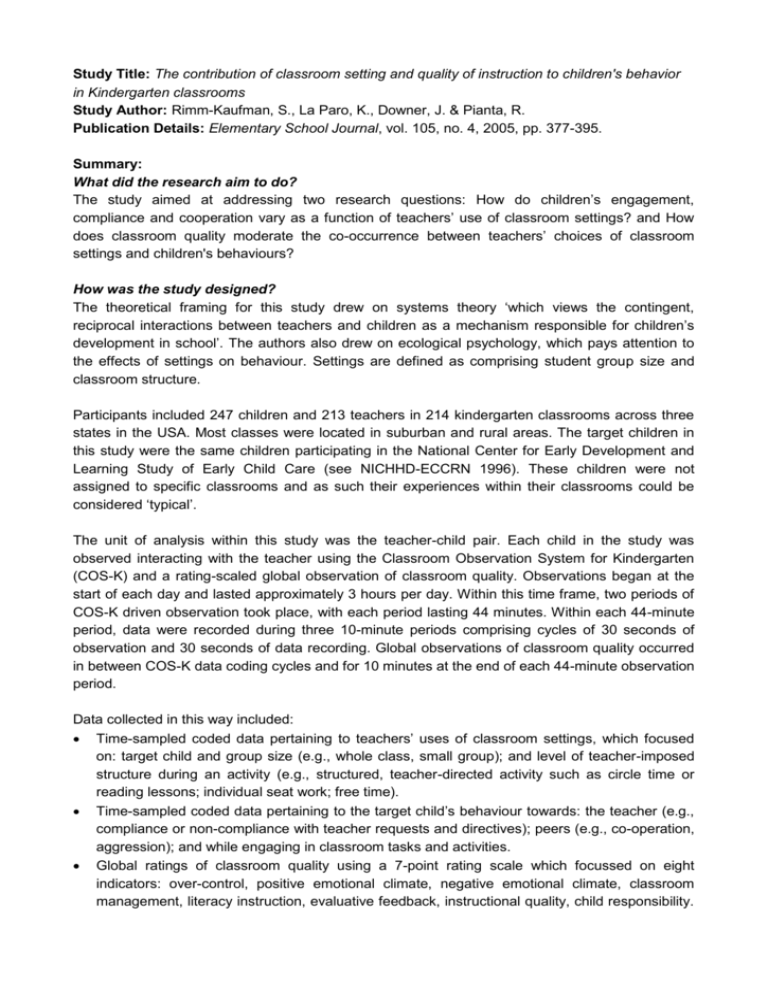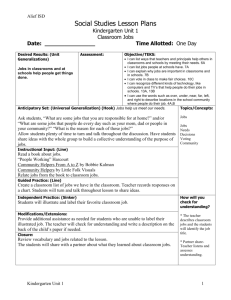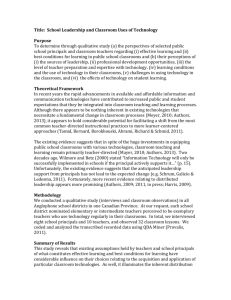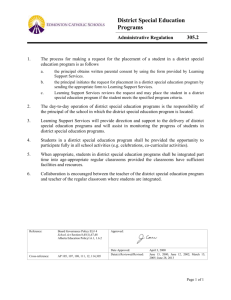The contribution of classroom setting and quality of instruction to
advertisement

Study Title: The contribution of classroom setting and quality of instruction to children's behavior in Kindergarten classrooms Study Author: Rimm-Kaufman, S., La Paro, K., Downer, J. & Pianta, R. Publication Details: Elementary School Journal, vol. 105, no. 4, 2005, pp. 377-395. Summary: What did the research aim to do? The study aimed at addressing two research questions: How do children’s engagement, compliance and cooperation vary as a function of teachers’ use of classroom settings? and How does classroom quality moderate the co-occurrence between teachers’ choices of classroom settings and children's behaviours? How was the study designed? The theoretical framing for this study drew on systems theory ‘which views the contingent, reciprocal interactions between teachers and children as a mechanism responsible for children’s development in school’. The authors also drew on ecological psychology, which pays attention to the effects of settings on behaviour. Settings are defined as comprising student group size and classroom structure. Participants included 247 children and 213 teachers in 214 kindergarten classrooms across three states in the USA. Most classes were located in suburban and rural areas. The target children in this study were the same children participating in the National Center for Early Development and Learning Study of Early Child Care (see NICHHD-ECCRN 1996). These children were not assigned to specific classrooms and as such their experiences within their classrooms could be considered ‘typical’. The unit of analysis within this study was the teacher-child pair. Each child in the study was observed interacting with the teacher using the Classroom Observation System for Kindergarten (COS-K) and a rating-scaled global observation of classroom quality. Observations began at the start of each day and lasted approximately 3 hours per day. Within this time frame, two periods of COS-K driven observation took place, with each period lasting 44 minutes. Within each 44-minute period, data were recorded during three 10-minute periods comprising cycles of 30 seconds of observation and 30 seconds of data recording. Global observations of classroom quality occurred in between COS-K data coding cycles and for 10 minutes at the end of each 44-minute observation period. Data collected in this way included: Time-sampled coded data pertaining to teachers’ uses of classroom settings, which focused on: target child and group size (e.g., whole class, small group); and level of teacher-imposed structure during an activity (e.g., structured, teacher-directed activity such as circle time or reading lessons; individual seat work; free time). Time-sampled coded data pertaining to the target child’s behaviour towards: the teacher (e.g., compliance or non-compliance with teacher requests and directives); peers (e.g., co-operation, aggression); and while engaging in classroom tasks and activities. Global ratings of classroom quality using a 7-point rating scale which focussed on eight indicators: over-control, positive emotional climate, negative emotional climate, classroom management, literacy instruction, evaluative feedback, instructional quality, child responsibility. (Definitions of each code category are provided in an earlier paper; see Pianta, Lo Paro, Payner, Cox and Bradley 2002). Data were analysed using a series of statistical tests, including: descriptive statistics that focused on the rate and frequency of behaviours, regression analysis for testing the main hypothesis underpinning study (i.e. that classroom quality moderates the relationship between settings and child behaviour), and chi-square analyses examining associations between behaviour and settings. What were the limitations? The authors identified three limitations in their study. The non-compliance category proved most striking in the statistical results for this study; however, very few instances of non-compliance occurred overall, which limits the implications that can be drawn from these data. Moreover, the category itself requires situations where the teacher provides directives or asks questions to which a child must respond. Therefore, children in classrooms where teachers make fewer requests or give fewer directives are by default likely to appear less non-compliant than children in classrooms where the teacher makes many requests or gives many directives. Observation data were limited to the codes used to guide data recording, and depth of detail was constrained by observations occurring on only one day per target child. The authors admit this fell short of ‘best practice’ for classroom observation which ideally calls for multiple assessments across varied contexts. The definition of ‘engagement’ focused solely on ‘on-task’ and ‘off-task’ categories of behaviour. This did not take into account the ‘activeness’ or ‘passiveness’ of engagement which limited the breadth and depth of engagement data collected. What were the findings? There are five key findings. First, incidences of aggression towards peers (albeit low in number across the entire data set) were more likely to be found in structured, teacher-directed small group activities than in other kinds of activities although, second, a high classroom quality rating also seemed to match a greater rate of children’s ‘social conversation and cooperation with peers’ in small group settings. Third, a high classroom quality rating tended to match fewer instances of problem behaviours (e.g., non-compliance, off-task behaviour). Fourth, children were more likely to comply with teacher directives in structured, teacher-directed activities than in other settings. Fifth, children were more likely to be off-task within whole-class settings than in other settings. What conclusions were drawn from the research? Overall, it appears that high classroom quality was most consistently related to a low number of problem behaviours, regardless of classroom setting. Even when the setting required students to work independently or cooperatively with peers, high quality classrooms appeared to provide sufficient emotional and instructional support for these kindergarten children to navigate the challenges of developing self-responsibility within different classroom management configurations and degrees of teacher attention. What are the implications of the study? A combination of small-group settings and high-quality teacher-child interactions can produce social exchanges among peers and low incidences of non-compliance that contribute positively to a child’s overall academic development. Generalisability and significance for Queensland The study is a useful reminder that varied classroom management configurations and high quality levels of emotional and instructional support for student learning all contribute positively to students’ academic outcomes. Where can interested readers find out more? National Institute for Child Health and Human Development-Early Child Care Research Network (NICHHD-ECCRN), 1996, ‘Characteristics of infant child care: Factors contributing to positive care giving’, Early Childhood Research Quarterly, vol. 11, pp. 296-306. Pianta, R., La Paro, K., Payne, C., Cox, M. & Bradley, R. 2002, ‘The relation of kindergarten classroom environment to teacher, family, and school characteristics and child outcomes’, Elementary School Journal, vol. 102, no. 3, pp. 225-238. Rimm-Kaufman, S., Pianta, R., & Cox, M. 2000, ‘Teachers' judgments of success in the transition to kindergarten’, Early Childhood Research Quarterly, vol. 15, no. 2, pp. 147-166. Keywords: early years, pedagogy








